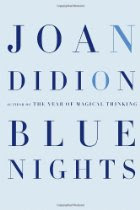Wednesday, November 7, 2012
December Not Fiction Book Discussions
Within two years, author and critic Joan Didion lost her husband, John Gregory Dunne, and her daughter, Quintana Roo Dunne Michael. Her husband died suddenly of a heart attack in December 2003 while her daughter was in the ICU with sepsis, just one of a string of mysterious illnesses leading to her death in August 2005. Didion describes her grief over her husband's death in her memoir The Year of Magical Thinking, which sold over a million copies, won a National Book Award, and was made into Broadway play starring Vanessa Redgrave. She shares details from their married and shared professional lives and honestly describes the madness brought on by grief that allows one to believe that the beloved is not truly gone--the "magical thinking" of the title. In Blue Nights, however, a companion of sorts to The Year of Magical Thinking, Didion does not offer us another memoir of grief. Instead, she explores a frequent and even darker companion to grief, regret.
Readers expecting to follow a linear narrative of Quintana Roo's charmed but emotionally troubled childhood, to learn specific details about her series of illnesses and death, and to find catharsis and learn to accept that death along with Didion may find themselves disappointed. Instead, they consider with Didion the very uncomfortable question of whether, and to what extent, she herself was responsible for Quintana's unhappiness. Meghan O'Rourke, in her review of Blue Nights at slate.com, says, "The regret memoir is another thing altogether, a stranger, patchwork beast. It is written by an author with no hope of recovery, who has let go of her magical thinking. It is pricklier, more nihilistic, composed knowing that the center hasn't held, rather than out of a fraught awareness that the 'center cannot hold.' . . . The book instead bears witness to the realization that the past can never be fixed (a realization many parents must at some point confront)." Didion also confesses her inability to rely on her famous elliptical style to write about Quintana and realizes that she has perhaps often chosen style over substance in her own life. As O'Rourke notes, "the story is about how style becomes a tactic that prevents you from being in the moment. . . . her writing taps into one of postwar life's most vital contradictions. It dismantles myths and self-mythologizes at the same time. It exposes a generation's narcissism while at times embodying it." And in facing the death of her child and the inadequacy of her writing to help her deal with it, Didion confronts the uncomfortable fact of her own mortality.
While readers might not get what they expected in Blue Nights, they must surely recognize Didion's courage to share with her readers the more difficult story. Sometimes we turn to writers to show us how not to live.
We hope you will join the discussion: Tuesday, November 13, at 6:30 p.m. at Main Library; Thursday, November 29, at 11:00 a.m. at West Ashley Branch Library; and here on the blog.
Readers expecting to follow a linear narrative of Quintana Roo's charmed but emotionally troubled childhood, to learn specific details about her series of illnesses and death, and to find catharsis and learn to accept that death along with Didion may find themselves disappointed. Instead, they consider with Didion the very uncomfortable question of whether, and to what extent, she herself was responsible for Quintana's unhappiness. Meghan O'Rourke, in her review of Blue Nights at slate.com, says, "The regret memoir is another thing altogether, a stranger, patchwork beast. It is written by an author with no hope of recovery, who has let go of her magical thinking. It is pricklier, more nihilistic, composed knowing that the center hasn't held, rather than out of a fraught awareness that the 'center cannot hold.' . . . The book instead bears witness to the realization that the past can never be fixed (a realization many parents must at some point confront)." Didion also confesses her inability to rely on her famous elliptical style to write about Quintana and realizes that she has perhaps often chosen style over substance in her own life. As O'Rourke notes, "the story is about how style becomes a tactic that prevents you from being in the moment. . . . her writing taps into one of postwar life's most vital contradictions. It dismantles myths and self-mythologizes at the same time. It exposes a generation's narcissism while at times embodying it." And in facing the death of her child and the inadequacy of her writing to help her deal with it, Didion confronts the uncomfortable fact of her own mortality.
While readers might not get what they expected in Blue Nights, they must surely recognize Didion's courage to share with her readers the more difficult story. Sometimes we turn to writers to show us how not to live.
We hope you will join the discussion: Tuesday, November 13, at 6:30 p.m. at Main Library; Thursday, November 29, at 11:00 a.m. at West Ashley Branch Library; and here on the blog.
Subscribe to:
Post Comments (Atom)


No comments:
Post a Comment
For reference, informational, or circulation questions or comments, please use our Ask-A-Question and Catalog Questions services at www.ccpl.org.